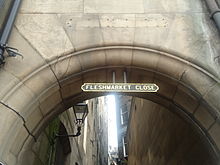- Cockburn Street, Edinburgh
-
Cockburn Street is a picturesque street in Edinburgh's Old Town[1], created as a serpentine link from the Royal Mile to Waverley Station in 1856[2]. It is named after the Scottish lawyer, judge and literary figure Henry, Lord Cockburn who was influential in urging his fellow citizens to remain vigilant in ensuring that early-Victorian expansion, e.g. improvements such as Cockburn Street, did not irrevocably damage or obliterate the built heritage and environment.
The street contains a series of small specialist shops.
Contents
History
The street was sliced through the previous medieval pattern of closes in order to give a more gentle gradient and wider thoroughfare to the station. The truncated ends of the closes were remodelled in the Scots Baronial style 1859 to 1864, but to the untrained eye are often presumed to be medieval in date.
The street is largely 4 storeys high but is dominated by the huge rear edifice of the City Chambers, which tower 12 storeys above the street as seen from this side. Given that the building dates from 1761, this is evidence to Edinburgh's fondness for high-rise structures dating back to the 18th century.
One of the more famous closes divided by the street is Fleshmarket Close. Both this and Anchor Close maintain the medieval pattern of Edinburgh's Old Town in this area.
Notable features
One of the buildings on the north side has high level carvings of an owl and pussycat, linking to the then contemporary poem The Owl and the Pussycat by Edward Lear.
Featured in film
The roofscape and one of the top flats appear prominently in the film Hallam Foe.
References
- ^ http://www.edinburgh-royalmile.com/off-royalmile-photos/cockburn-st/cockburn-st-01.html
- ^ Buildings of Scotland: Edinburgh, by Colin McWilliam
Categories:- Old Town, Edinburgh
- Streets in Edinburgh
- Shopping streets in Scotland
- Visitor attractions in Edinburgh
Wikimedia Foundation. 2010.


